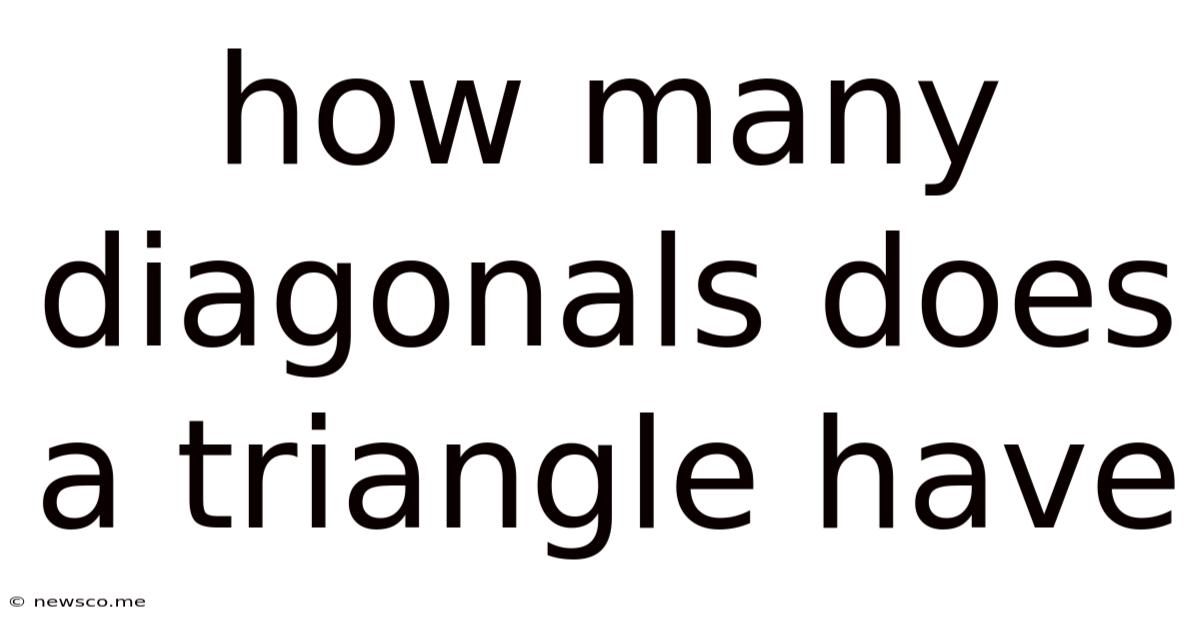How Many Diagonals Does A Triangle Have
News Co
Apr 17, 2025 · 5 min read

Table of Contents
How Many Diagonals Does a Triangle Have? A Deep Dive into Geometry
Understanding the diagonals of polygons, particularly simple shapes like triangles, is fundamental to grasping geometric principles. This seemingly simple question – how many diagonals does a triangle have – opens a door to exploring fundamental concepts of geometry, and ultimately, understanding more complex shapes.
What is a Diagonal?
Before we tackle the triangle, let's define what a diagonal actually is. A diagonal is a line segment connecting two non-adjacent vertices of a polygon. Crucially, it's inside the polygon and doesn't form one of its sides. This distinction is key. Imagine trying to draw a line connecting adjacent vertices – that's just a side, not a diagonal.
The Triangle: A Unique Case
Triangles, being the simplest polygons (requiring only three sides to form a closed shape), present a unique situation when considering diagonals. Let's visualize a triangle with vertices A, B, and C. To draw a diagonal, we need to connect two non-adjacent vertices. However, in a triangle, all vertices are adjacent to each other. There are no vertices that aren't directly connected by a side.
Therefore, the answer is straightforward:
A triangle has zero diagonals.
Formula for Calculating Diagonals in Polygons
While triangles are an exception, a formula exists to calculate the number of diagonals in polygons with more than three sides. The formula is:
n(n-3) / 2
Where 'n' represents the number of sides (or vertices) of the polygon.
Let's test this:
- Square (n=4): 4(4-3)/2 = 2 diagonals. This is correct; a square has two diagonals.
- Pentagon (n=5): 5(5-3)/2 = 5 diagonals. Again, a pentagon has five diagonals.
- Hexagon (n=6): 6(6-3)/2 = 9 diagonals. A hexagon indeed possesses nine diagonals.
This formula highlights the unique nature of the triangle. If we try to apply it to a triangle (n=3):
3(3-3)/2 = 0 diagonals.
The formula confirms our visual observation: a triangle has no diagonals.
Deeper Understanding: Why the Formula Works
The formula's logic rests on the understanding that each vertex can be connected to (n-3) other vertices to form diagonals (we subtract 3 because we exclude the vertex itself and its two adjacent vertices). Since we're counting pairs of vertices, we divide the result by 2 to avoid double-counting each diagonal.
Exploring Related Geometric Concepts
Understanding the absence of diagonals in a triangle helps illuminate several crucial geometrical concepts:
1. Rigidity of Triangles:
The lack of internal lines, such as diagonals, contributes to the inherent rigidity of triangles. Unlike quadrilaterals or polygons with more sides, a triangle’s shape is completely determined by the lengths of its three sides. You can't deform a triangle without changing the lengths of its sides. This property makes triangles essential structural components in various applications, from bridges to buildings.
2. Triangulation:
The inability to add internal lines within a triangle is the foundation of triangulation, a fundamental technique in surveying, computer graphics, and other fields. Complex shapes are often broken down into a network of triangles to simplify calculations and analysis. The rigidity and well-defined properties of triangles make them ideal building blocks for this process.
3. Types of Triangles:
The absence of diagonals doesn't affect the classification of triangles. We can still categorize triangles based on their side lengths (equilateral, isosceles, scalene) or their angles (acute, obtuse, right-angled). These classifications describe the triangles themselves, not the lines within them.
4. Area Calculations:
The area of a triangle can be calculated using various formulas, such as ½ * base * height or Heron's formula. None of these formulas involve diagonals, further emphasizing their irrelevance to the fundamental properties of triangles.
Triangles in Different Contexts
The seemingly simple concept of a triangle and its lack of diagonals plays a significant role in various fields:
1. Engineering and Architecture:
Triangles are foundational in structural engineering and architecture due to their inherent stability. The rigidity of a triangle ensures that structures built using triangular frameworks are less prone to deformation under stress. Think of truss bridges or the triangular bracing in buildings – these structures leverage the properties of triangles to maximize strength and stability.
2. Computer Graphics and Game Development:
Triangles are the fundamental building blocks of 3D models and graphics. Complex 3D objects are often represented as a mesh of interconnected triangles. The simplicity and predictable nature of triangles make them computationally efficient to process, rendering them ideal for computer graphics and game development.
3. Cartography and Surveying:
Triangulation, the process of dividing an area into triangles to determine distances and positions, is crucial in cartography and surveying. This technique relies on the precisely defined relationships between the sides and angles of triangles to accurately map land areas.
Conclusion: The Significance of Simplicity
The answer to the question – "how many diagonals does a triangle have?" – is a seemingly trivial zero. However, this simple answer is deeply interwoven with the fundamental properties of triangles, which have far-reaching implications in various fields. Understanding why a triangle lacks diagonals provides insight into the inherent stability, efficiency, and wide applicability of this basic geometric shape. Its simplicity belies its crucial importance in more complex geometric systems and real-world applications. The absence of diagonals in a triangle highlights its unique status among polygons and is a keystone to grasping more complex geometric principles. This seemingly simple question offers a profound gateway to understanding the intricate world of geometry.
Latest Posts
Related Post
Thank you for visiting our website which covers about How Many Diagonals Does A Triangle Have . We hope the information provided has been useful to you. Feel free to contact us if you have any questions or need further assistance. See you next time and don't miss to bookmark.